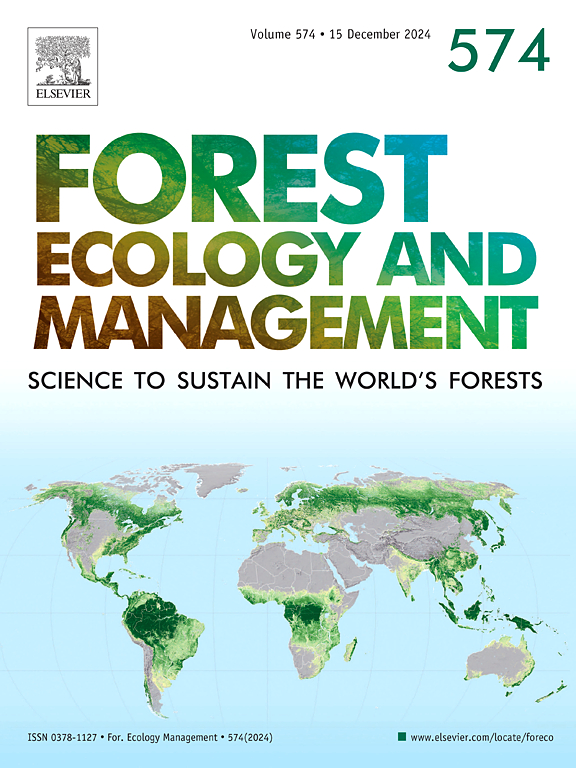Spectral signatures discrimination of Norway spruce trees under experimentally induced drought and acute thermal stress using hyperspectral imaging
IF 3.7
2区 农林科学
Q1 FORESTRY
引用次数: 0
Abstract
Climate change intensifies drought and thermal stress in forests, weakening tree vitality and increasing susceptibility to Ips typographus (L.) infestations. This study evaluates the potential of hyperspectral remote sensing to detect physiological stress in Norway spruce (Picea abies (L.) Karst.) induced by chronic drought and acute thermal stress. An in situ manipulation experiment was conducted within a mature spruce stand, establishing precipitation-exclusion roofs (chronic drought), stand edges (acute thermal stress), and control plots. High resolution hyperspectral imagery data was collected across visible, NIR, and SWIR wavelengths (380–2500 nm) during six flights (2022–2023) using CASI-1500 (0.5 m) and SASI-600 (1.25 m) hyperspectral cameras.
Spectral discrimination revealed significant differences between stressed and control trees, particularly in the red (669.58 nm), NIR (854.96 nm), and SWIR (1557.5 nm, 2082.5 nm) wavebands, while the green region (498.56 nm) separated better in reflectance than in derivative analyses. These wavebands effectively identified physiological changes, including pigment depletion, reduced water content, and nitrogen fluctuations. Spectral separations were strongest in late summer and autumn, coinciding with intensified stress responses. Acute stress showed variable NIR reflectance trends, increasing in autumn but declining in August 2023. Chronic stress exhibited higher SWIR reflectance, indicating reduced needle water content. Statistical analyses, including the Kruskal-Wallis test and post hoc Dunn and Mann-Whitney U tests, confirmed significant spectral separability between stress types.
These spectral markers provide a framework for monitoring tree stress under variable environmental conditions. By integrating remote sensing with climatic data, this study demonstrates how hyperspectral imaging enables early stress detection, supporting proactive forest management against climate-induced threats.
利用高光谱成像技术识别挪威云杉在干旱和急性热胁迫下的光谱特征
气候变化加剧了森林的干旱和热胁迫,削弱了树木的活力,增加了对Ips (L.)侵染的易感性。本研究评估了高光谱遥感检测挪威云杉(Picea abies (L.))生理胁迫的潜力。喀斯特)引起的慢性干旱和急性热应力。在一个成熟的云杉林分内进行了原位操作试验,建立了疏雨屋顶(慢性干旱)、林分边缘(急性热应力)和对照样地。利用CASI-1500(0.5 m)和SASI-600(1.25 m)高光谱相机,在6次飞行(2022-2023)期间收集了可见光、近红外和SWIR波长(380-2500 nm)的高分辨率高光谱图像数据。光谱判别结果显示,胁迫树和对照树在红色(669.58 nm)、近红外(854.96 nm)和SWIR(1557.5 nm, 2082.5 nm)波段上存在显著差异,而绿色区域(498.56 nm)的反射率比导数分析分离得更好。这些波段有效地识别了生理变化,包括色素消耗、含水量减少和氮波动。光谱分离在夏末和秋季最强,与强烈的胁迫反应相一致。急性胁迫表现出不同的近红外反射率变化趋势,秋季增加,8月下降。慢性胁迫表现出较高的SWIR反射率,表明针叶含水量降低。统计分析,包括Kruskal-Wallis测试和事后的Dunn和Mann-Whitney U测试,证实了压力类型之间显著的光谱可分性。这些光谱标记为监测树木在不同环境条件下的应力提供了一个框架。通过将遥感与气候数据相结合,本研究展示了高光谱成像如何能够实现早期应力检测,支持针对气候引起的威胁进行主动森林管理。
本文章由计算机程序翻译,如有差异,请以英文原文为准。
求助全文
约1分钟内获得全文
求助全文
来源期刊

Forest Ecology and Management
农林科学-林学
CiteScore
7.50
自引率
10.80%
发文量
665
审稿时长
39 days
期刊介绍:
Forest Ecology and Management publishes scientific articles linking forest ecology with forest management, focusing on the application of biological, ecological and social knowledge to the management and conservation of plantations and natural forests. The scope of the journal includes all forest ecosystems of the world.
A peer-review process ensures the quality and international interest of the manuscripts accepted for publication. The journal encourages communication between scientists in disparate fields who share a common interest in ecology and forest management, bridging the gap between research workers and forest managers.
We encourage submission of papers that will have the strongest interest and value to the Journal''s international readership. Some key features of papers with strong interest include:
1. Clear connections between the ecology and management of forests;
2. Novel ideas or approaches to important challenges in forest ecology and management;
3. Studies that address a population of interest beyond the scale of single research sites, Three key points in the design of forest experiments, Forest Ecology and Management 255 (2008) 2022-2023);
4. Review Articles on timely, important topics. Authors are welcome to contact one of the editors to discuss the suitability of a potential review manuscript.
The Journal encourages proposals for special issues examining important areas of forest ecology and management. Potential guest editors should contact any of the Editors to begin discussions about topics, potential papers, and other details.
 求助内容:
求助内容: 应助结果提醒方式:
应助结果提醒方式:


